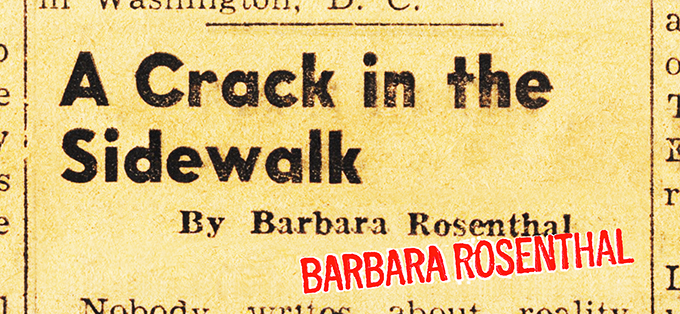***
Roles, Ideals and Job Descriptions:
The Artist; The Viewer; The Naif; The Collector;
The Curator; The Critic; The Art Dealer
by Barbara Rosenthal
Contributing Columnist
NYC, May 1, 2018
Try as I might continue to try, conclusions and boundaries elude me as I see in our contemporary artworld an exponentially growing trend toward assuming multiple roles. Time was ethos was, for example, no curators or critics in the same shows they curated or reviewed; no gallerist taken seriously when they said they were also an artist; no curator or critic too close to anyone in the project; or for an artist to be anything but, in terms of the above-mentioned professions.
This is clearly not the ethos now. What seems to prompt each new “crack in the sidewalk” each impetus for each next of my columns, has been a sudden slice or shaft or beam into concept at a particular moment of regular Reality. This one was sparked at a panel hosted by Noah Becker at Lichtundfire, on Rivington Street, one of my favorite haunts. I had made a studio visit several years ago to see his portraits, so I knew him as an artist; and I had subsequently come to know him as publisher and editor of Whitehot Magazine of Contemporary Art, in which he conducts interviews and writes reviews. At Lichtundfire I learned that he came to NY from Canada in 2004, and in 2015 was curator of such exhibitions as “60 Americans” at the Elga Wimmer Gallery, another interesting space I’ve been frequenting this year, too. As the panelists introduced themselves, I noticed that all are roughly in their 40s and emigres to NY who are shaping The Downtown Scene. When I realized that each occupies multiple roles with a great deal of overlap, a crack opened into what might lay beneath to differentiate the roles themselves in theory and in practice. Concepts that might be treated separately in depth, in future columns, are typed here with first-letter-caps. This is what I’ve got so far:
- The Artist
The Ideal Artist: In every culture, The Artist is a revered medium of transmission between The Individual and The Cosmos, for which they are given Special Status. Artists create tangible or conceptual manifestations of The Sublime, called Works of Art. Done right, a Work of Art produces a Bio-esthetic Response, Ecstatic Moments, in Viewers. A Work of Art reflects the individual personality and World View of The Artist, as well as insight into their medium and their time.
Degraded / Corrupt Artists: Use their skills and Special Status to create, transmit and promote Propaganda. Propaganda is work meant to carry a specific point of view or idea (meme) to others. Such works, for example in Advertising or Political Art, illustrate by words and/or images concepts or persuasions they can already articulate and want others to ally with.
- The Viewer / The Naif
Viewers are at liberty to deduce any analysis — personal, conceptual, mythological, sexual, symbolic, referential — and give it free expression. The Ideal Viewer is The Naif.
The Naif expects that Works of Art will induce engagement with larger horizons of some kind, and to produce a Bio-esthetic Response and Ecstatic Moment(s). Naifs, having no foreknowledge or expectation, suspend themselves before artworks that beckon them across the floor, compelling closer, dead-on range. The Ideal Viewer opens to what might have been behind The Artist’s mind, program and structure, the revelations of the artwork. The Ideal Art-educated Viewer approaches artworks with the openness of a naif, but is able to identify and respond to the elements of its construction that elicit their reactions.
Degraded / Corrupt / Predatory Viewers: Besides those who come with prefashioned tastes, prejudices and agendas, the most Degraded and Corrupt Viewers are the Intellectual-property-thieves, Predatory Viewers who raid artworks for unique features hard-won by the artists who developed them. (More on “appropriation” in a future column.) Besides bad sportsmanship, and the degradation of honorable characteristics, and the resultant disheartening of many gifted Artists. Numbing modifications are almost always made to once-good now-stolen ideas, technique, text, etc, as well. (See also my project Avant-garde / Classical / Mainstream. Such alterations denude and despoil original, often spectacular Works of Art because every such theft diminishes the most astonishing features in order to make it more palatable to their own limited minds and followers. Intellectual theft and its double whammy resultant dilution of the source and the effect, turns a warm, blazing fire into a pile of pissed-out ashes and cold stones.
- The Collector
A work of art has monetary value because it is known to deeply resonate with many people. Particular works, such as the Mona Lisa, are worth particularly huge sums because they are particularly good at it. The possession of a Work of Art that is catalytic to The Collector’s Ecstatic Moment, if it be shown around and found to have equal resonance with others will appreciate in value.
Ideal Collectors: Those who collect work for themselves that elicit Ecstatic Moments in themselves.
Corrupt or Degraded Collectors: Forgeries; forced sales; looted works; recently stolen antiquities; bad restoration. Collectors who hide their works away in vaults and never show them.
- The Curator
We are seeing this designation applied recently to apparel and furniture. It implies that a person of “Taste” has made selections for you. In art schools, it’s become a hot major. In its Ideal form, it is a noble, undervalued profession; in its degraded form it is a scourge.
Ideal Curators: With a deep factual and image-bank knowledge of a particular field and the sub-fields around it, the Ideal Curator receives their Bio-esthetic jolt at the moment of their inspirational identification or discovery of a unique feature or trend or unifying principle. They then cull a number of examples for a collection, exhibition, article or book. It is Works of Art themselves that give rise to the inspiration of The Ideal Curator. Thus Ideal Curators bring attention to phenomena they have noticed, and then conjecture as to its significance.
Corrupt and Degradé Curators: Corrupt Curators, in the simplest form, base selections on self or personal friends regardless of quality. There are also subtle forms of corruption, such as charging artists participation fees or favors. But I see the most insidious form of Degraded Curators being those who make The Artist yield creative instinct to their Gatekeeping Power: This Assignment-giver Curator tempts Artists with promise of exhibition if they yield their prerogative to think for themselves. Such curators degrade artists by subjugating them into the role of dullard manufacturers of Curators’ own (usually half-baked, over-used and propagandistic) ideas. And they degrade art-making altogether by hijacking the Moment of Inspiration.
- The Critic
Ideal Critics describe Works of Art with high accuracy; define them within stated parameters; compare them to other works of historical and contemporary relevance in terms of form, materials and concept; and conjecture about whatever unique psychological and cultural significance they might have, based on the inner workings of The Artist’s mind and outer workings of both their experiences.
Degraded or Corrupt Critics: Critics with bias about how any medium or form or concept is used, or by whomever; any agenda. (I’ll exempt bias against works that cause physical pain or suffering.) Critics who might gain any advantage, reciprocity from or unprofessional connection to The Artist or The Art Dealer, tangible or social.
- The Art Dealer
Ideal Art Dealers: are those whose Bio-esthetic Moments come as they build collections of works for others (see also: The Collector). Ideal Art Dealers actively seek out specific collectors for artists whose work provides Ecstatic Moments. They happily enrich Artists for providing such works. Ideal Art Dealers do not interfere with what their artists continue to create. And it goes without saying that they handle artworks carefully, publicize them appropriately, find them great museum shows, pay fairly and on time. (And very ideal ones include a residuals clause.)
Corrupt or Degraded Art Dealers: Corrupt, nefarious dealings include shady authenticity, provenance and finances. A Degraded Art Dealer is one who offers only easy-to-sell Works of Art often of lesser qualities, however those things can be defined in their markets.
`
About the author:
 Barbara Rosenthal is an idiosyncratic New York artist/writer/performer/philosopher whose latest book, the novel, Wish for Amnesia (Deadly Chaps Press, 2017) explores themes of idealism, innocence, esthetics, dimensionality, thought and corruption. She is particularly interested in the intersection of art and life.
Barbara Rosenthal is an idiosyncratic New York artist/writer/performer/philosopher whose latest book, the novel, Wish for Amnesia (Deadly Chaps Press, 2017) explores themes of idealism, innocence, esthetics, dimensionality, thought and corruption. She is particularly interested in the intersection of art and life.
About the novel: wishforamnesia.com
Calendar of events: http://www.emedialoft.org/artistspages/frameEleven.htm
To comment on this column, please message FACEBOOK: https://www.facebook.barbara.rosenthal1.com
WIKIPEDIA: https://en.wikipedia.org/wiki/Barbara_Rosenthal
WEBSITE: http://www.barbararosenthal.org
Bi-MONTHLY COLUMNS: Barbara Rosenthal, A Crack in the Sidewalk:
May-June, 2018: Roles, Ideals and Job Descriptions: The Artist; The Viewer; The Naif; The Collector; The Curator; The Critic; The Art Dealer
March-April, 2018: The Production of Meaning in Art Fabrication: What Are You Doing? Do You Know? When? Before or After?
Jan-Feb, 2018: Is There a Universal Esthetic? Naifs, Innocence, Education, Esthetics
Nov-Dec, 2017: Journaling
Sept-Oct, 2017: by this first sentence here now, back upon the Earth.

Recent Comments